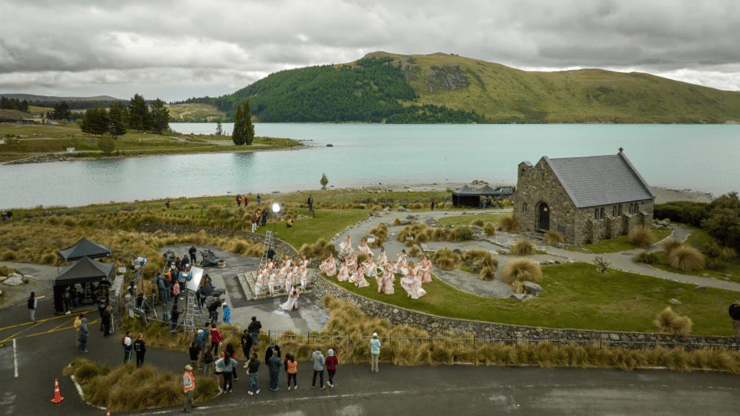NZ Film Sector Looks To Revive Golden Era Of Indian Cinema

The screen relationship between India and New Zealand spans three decades, with a golden period in the 1990s and early 2000s when more than 100 Indian films were shot in the South Pacific nation.
The first recorded Indian production that was filmed in New Zealand was Sanam Harjai in 1995, which included scenes shot in Christchurch, Queenstown, Punakaiki and Wanaka.
However, it was 2000 blockbuster Kaho Naa … Pyaar Hai (Say It Is Love), starring Hrithik Roshan, that truly put New Zealand on the Bollywood map.
Filmed extensively in the South Island, the production became one of the highest-grossing Indian movies of its time.
"New Zealand is so beautiful, it won't [fall off] the radar of producers looking for scenic locations," said Petrina D'Rozario, head of Screen Canterbury. "I remember watching a film called Kaho Na … Pyar Hai and, of course, those locations took you by storm."
D'Rozario moved to New Zealand in 2003 after working in Bollywood for more than a decade.
She said the film's success played a key role in promoting New Zealand, especially the South Island, as both a filming location and a tourism destination.
However, the momentum had since waned.
"It kind of slowed down," D'Rozario said. "From what I gather, it's gone down to one movie a year or one every alternate year these days."

Petrina D'Rozario is head of Screen Canterbury. Photo: Supplied
D'Rozario is now working to change that, both for Screen Canterbury and the broader New Zealand film industry.
Screen Canterbury is one of 10 regional film offices in New Zealand.
In 2021, the Christchurch City Council approved a $1.5 million Screen Canterbury NZ production grant to attract both domestic and international productions to the region.
Recently, she travelled to Mumbai and Hyderabad to meet her Indian screen industry counterparts.
"We have a co-production treaty with India that is currently rarely utilised," she said.
Signed in 2011 under the John Key administration, the Film Co-Production Agreement was designed to enhance cooperation between the two countries' film industries - encouraging joint creative efforts, co-investment and crew exchange.
The agreement also granted approved projects the status of "official co-productions", making them eligible for national film benefits in both countries.
This included access to government funding, screen incentives and streamlined processes for temporary immigration and importing equipment.
New Zealand currently has co-production agreements or treaties with 17 countries, including India, Australia, Canada, China and the United Kingdom.
While D'Rozario reported positive conversations with Indian producers, she acknowledged they remained cautious with their investments.
"Countries like the UK, Australia, and Switzerland have better screen incentives to lure Indian producers, which could be one reason why the number of Indian productions in New Zealand has declined," she said.
"There are some bumps on the road, but I'm sure we can find a way."
She was hopeful the beginning of free trade negotiations between India and New Zealand would bring greater attention to the screen industry.
"I think the excitement is there, but I didn't see a lot of discussions about creative industries," she said.
"I'm hopeful we can submit our recommendations and be part of the FTA too - that is the goal."

Chris Payne is head of Co-production & Incentives at the New Zealand Film Commission. Photo: Supplied
"Any opportunity for closer ties between India and New Zealand is terrific," said Chris Payne, head of co-production and incentives at New Zealand Film Commission.
Payne said Prime Minister Christopher Luxon's recent trade mission to India included some "good elements" of engagement with Bollywood.
"In more recent times, the relationship has expanded to co-production activity, including a film called Beyond the Known World, that was made as a New Zealand-India co-production under the treaty and was directed by leading Indian filmmaker Pan Nalin," he said.
While acknowledging the decline in the number of Indian films being shot in New Zealand, Payne said the relationship was still active.
Recent examples included Kannappa, a Telugu-language film, and Game Changer, both of which shot scenes in New Zealand.
Payne also highlighted a growing interest in collaboration beyond location shoots.
"We want closer ties with India - not just as a filming location, but also as a digital destination and a strong partner in post-production and VFX," Payne said.
Several projects were currently in development that aimed to film in India or were part of co-production pipelines, he said.
"We're seeing a new generation of Indian-New Zealand filmmakers - many of whom are members of the Pan Asian Screen Collective - who are looking to tell stories of diaspora and connection between New Zealand and India," he said.

Prime Minister Christopher Luxon met Amir Khan and other actors during his trade mission to India last month. Photo: Supplied
The 2023 Census showed the Indian population had surpassed the Chinese community to become the third-largest ethnic group in New Zealand.
A total of 292,092 people in the country identified as a member of the Indian community in the 2023 Census, an increase of 22 percent since 2018.
Payne also pointed to an upcoming release of Ka Whawhai Tonu - Struggle Without End, a Māori-language historical drama that is preparing for an Indian release around the same time as Kannappa.
"I'd be really hopeful that there's a lot of bilateral and multilateral collaboration in the next five years," he said. "We see a huge opportunity for New Zealand firms to reach Indian audiences - and vice versa."
D'Rozario shared a similar sentiment.
"I believe we have a unique opportunity to engage with one of the largest film industries in the world and reintroduce New Zealand to its producers," she said.
"It's about building a bridge where New Zealand isn't just seen as a service provider, but as a destination for exchanging great talent and content."
This article was first published in RNZ





